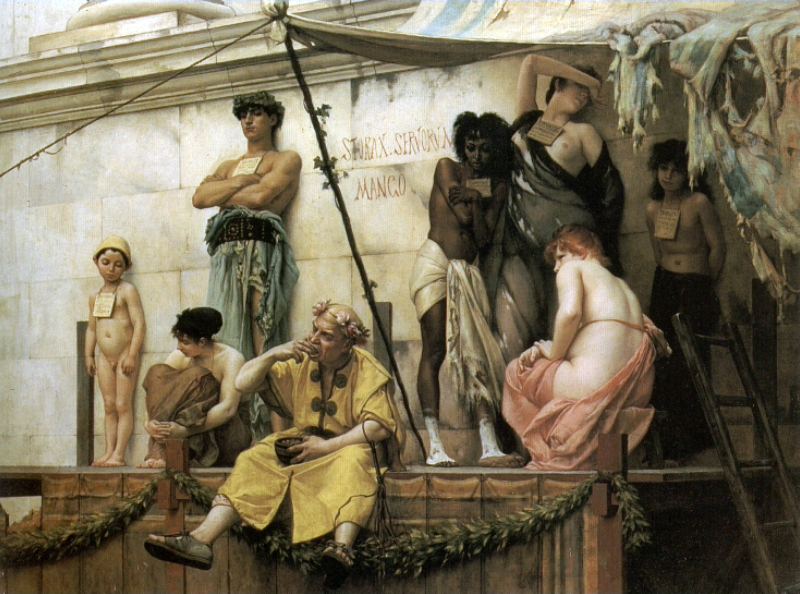The history of slavery dates back to a time well before the founding of Rome. Historical records indicate that slavery had been in existence four thousand years before the birth of Christ. In many civilizations, the use of slaves was a way of life. Slaves were considered to be nothing more than beasts of burden, property, like horses or oxen. Though the Romans were not the first to use slaves, they acquired an insatiable taste for it. No other civilization in history was more dependent on slavery than Rome. There is evidence to indicate that when the Roman Empire was at the height of its power, there were six million people living in Italy. Two million of those people were slaves.
There were slave-sale days during which the slave trader paraded his latest acquisitions of slaves naked along the street with placards describing the best qualities of each slave. Among the slaves captured were skilled laborers. Greek slaves were known to fetch a higher price since many of them were educated and served as doctors, librarians or teachers. Those with special talents served as artists and musicians. Slaves were also employed as cooks, waiters, gardeners, hairdressers, dressmakers, maids and even bodyguards.
Quite often, the disparity of economic status played a pivotal role in the making of slaves. It was important to adhere to one’s financial responsibilities, since it was quite possible for one to become a slave if he or she did not repay borrowed money or failed to pay taxes in a timely manner. The poor might find themselves forced to sell their children into slavery to a wealthier neighbor.
Many historical accounts of Roman culture indicate that slavery was a thriving business. Slave traders would often follow the Roman legions to foreign lands and await the outcome of their battle campaigns, hoping, of course, that the Romans would win. If the Romans were victorious, everyone privy to the transaction made money: the army, who sold the defeated soldiers and their families to the slave traders and the slave traders who, in turn, transported the slaves back to Rome where they were sold for a higher price. The capture of enemy soldiers on the battlefield and reducing them to slavery was quite risky. They were angry and resentful after having been reduced to slavery, and so they waited for just the right time to rebel against their masters. History tells of three such rebellions which became known as the Servile Wars, named for those who served and fought for their freedom.
The First Servile War, in 135 B.C., was led by a slave from Syria by the name of Eunus who was gifted with a great personality. In fact he was so likable, that his master employed him as an entertainer. Eunus might be considered one of history’s first stand-up comics. Besides telling jokes, he liked to put on slight-of-hand magic shows, which included breathing fire and juggling. His monologue was so outrageous that he would often announce to his audience that Sicilian society would soon experience a role reversal, in which his audience, the wealthy masters of Sicily, would be killed or enslaved and he would become their king.
The audience, consisting of wealthy landowners, would laugh so hard that they threw money at his feet. Each time Eunus received a generous tip, he would thank the patron and promised to spare the patron’s life when he became king. Of course these remarks encouraged more laughter and more tips.
While Eunus was entertaining the aristocracy, tensions across Sicily were brewing between slaves and masters. Many slave owners did not provide enough food and clothing for their slaves. The slaves, in order to provide for themselves, resorted to thievery, for which they were punished. Eunus was well aware of the situation and had not been spending all of his time telling jokes. While he kept his audience laughing, he had been planning to lead some 200,000 slaves across the Sicilian country side in a rebellion against their Roman masters. This gutsy group began its revolt by taking on the Roman Republic in the city of Enna, Sicily, led by Eunus and another slave named Cleon, who became Eunus’ military general.
From the start, the slaves seemed invincible, winning one battle after another. The powers of Rome, having encountered uprisings in the past, showed little concern, since slaves were considered innately powerless. As the conflict was approaching its third year, however, Rome began to reconsider the seriousness of the situation. Legions of soldiers were dispatched with orders to put an end to the rebellion. The war had lasted almost three years. Cleon, the commanding general, was killed in battle, and Eunus was taken prisoner. It is believed that he would have been executed by means of crucifixion, but he died before he could be punished.
For the next twenty-eight years, slave problems remained low-key, but by 104 B.C., once again on the Island of Sicily, the Second Servile War occurred in a most peculiar way. It seems that Gaius Marius, Consul of Rome, in planning a military campaign was in need of additional troops. Rome’s Italian allies, however, refused to supply the needed troops because Roman tax collectors had enslaved Italians unable to pay their taxes. Since Gaius Marius was a consul, he had the power to fix the problem. He therefore decreed that all allied-friendly Italians be freed from Roman slavery. Approximately 800 slaves were freed in Sicily.
Apparently, the process of freeing slaves resulted in some confusion for two groups of slaves: one group of non-Italians who believed they would also be freed and the other, who incorrectly believed they had been freed. When these two groups were ordered by the governor to return to their slave masters an insurrection ensued.
From the rebellion emerged an elected leader named Salvius, who had managed to amass an army of about 20,000 trained slaves and two thousand cavalry. They easily overpowered a Roman legion of 10,000 and were then joined by another ex-slave, named Athenion, and his men who came from the western part of Sicily.
Manius Aquillius, a consul of Rome, was called upon to quell the revolt, but he soon discovered that such a task would not be an easy one. The revolt lasted about four years with slaves resorting to guerilla tactics. Their hit-and-run method of warfare proved to be quite successful since it allowed a small bands of slaves to outwit and defeat larger groups of trained soldiers who were accustomed to meeting their enemies face to face on the battle field.
Salvius’ method of fighting seemed foolproof, but for some unknown reason, he made the mistake of changing his method of warfare. By some accounts, it is believed that he had taken the advice of Athenion, who suggested that he take the fight to the open field. It was in a field battle that Salvius was killed. Athenion was wounded but he managed to escape and continue fighting for a while longer. Eventually, he was also defeated and killed by the forces of Consul Manius Aquillius.
The remaining slaves were taken prisoner. The timing of their defeat could not have been worse, since gladiator games were becoming one of the more popular forms of entertainment in Rome. Rome had plans for their future. But rather than end their days as gladiators in the arena, they chose to commit suicide.
For more than two decades there was relative calm in Rome until a single soldier emerged from within the ranks of the Roman legions and whose name was destined to be on the lips of many Romans who feared for their lives. He went by the name, Spartacus.
To be continued.






























